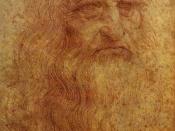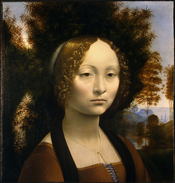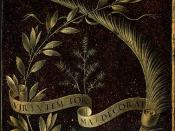Juxtaposed to the dark ages, is an age of light, an era of new discoveries and new ambitions. It is the age of the Renaissance: "this century, like a golden age, restored light to the liberal arts" (Cornell 188), as well as sciences and humanity. Leonardo da Vinci is the supreme example of a Renaissance genius; therefore, it is through the window of his art that we will discover the stylistic conventions and manifestations of this period. The piece under observation is Ginevra de' Benci, a Florentine portrait, which illuminates Leonardo's concerns, renowned techniques, and contemporary influences. Created in 1474, Florence, Italy, Ginevra de' Benci is one of the many masterpieces that reshaped the artistic world of the High Renaissance.
Upon gazing at Ginevra de' Benci, one may become aware of the simplistic details, which allude the viewer to its contemporary time and place. For example, the independent nature of the sitter insinuates where it was created.
During the Renaissance, it was rare for a woman to be depicted without her husband (Broude and Garrard 59). Paintings of this sort were exclusively created in Florence, Italy, which correspondingly was the home of Leonardo in the 1470s (McLanathan 31). Also, minor details such as the juniper tree in the background and inscription on the obverse reveal that Ginevra de' Benci is in fact a wedding portrait, therefore designating it to an era when such a patriarchal wedding portrait was common - the sixteenth century (Marani 38). Even the overlooked detail that it was done in oil on canvas mildly reflects the advancing era; as travel was becoming easier and safer, these materials were replacing the traditional, but stationary, frescos (Stolkstad 316).
A canvas is the tool, in which Leonardo applied his views "to transform the viewer's sense of the...


